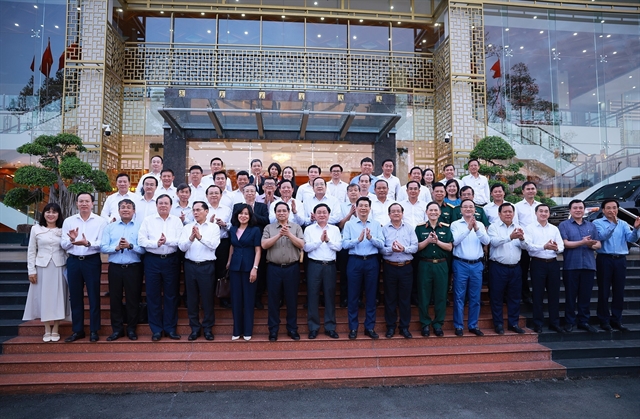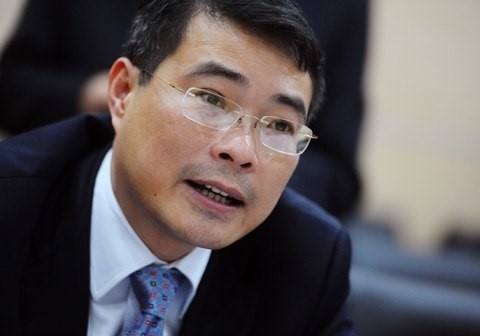 Economy
Economy

Việt Nam News reporter Ngọc Bích talks with the State Bank of Việt Nam’s Governor Lê Minh Hưng about the opportunities and challenges that the banking system will face in the near future.
 |
| State Bank of Việt Nam’s Governor Lê Minh Hưng. — Photo zing.vn |
Year 2015 was an important milestone in Việt Nam’s international economic integration with two significant events: establishment of ASEAN Economic Community (AEC) and wrapping up of Trans-Pacific Partnership (TPP) negotiations.
Việt Nam News reporter Ngọc Bích talks with the State Bank of Việt Nam’s Governor Lê Minh Hưng about the opportunities and challenges that the banking system will face in the near future.
How do you see the opportunities that TPP and AEC will offer to the Vietnamese banking sector?
In terms of openness and trade liberalisation, the AEC establishment aims at creating a single market for all ten Southeast Asian countries, thereby giving them more preferential access to member markets and promoting their presence at the markets. The TPP agreement is deemed as “the 21st century trade agreement” with large coverage, requirements for full liberalisation as well as regulations ensuring a stable and favourable business environment for investors. Specifically, joining the regional and international playground, will bring promising opportunities.
Firstly, it is expected that after the TPP comes into effect, Việt Nam will receive a large flow of foreign capital into the economy in general and the financial services sector in particular, facilitating the banking system to improve its financial capacity and access low-cost capital sources. An increased participation by foreign investors in the sector will help boost the transfer of technology, knowledge and high-level management skills. The positive factors will be an important impetus for the banking sector to develop efficiently, and sustainably in compliance with regional and international rules.
Secondly, participating in the AEC and TPP offers an opportunity for the Vietnamese banking sector to integrate more deeply into the regional and international financial markets. Along with the flourishing of export enterprises, the role of Vietnamese banks as a bridge to effectively channel capital among economies and businesses, will be promoted. The participation will also be a driving force for commercial banks as well as other local enterprises to compete for survival and development, not only in the country but also abroad.
What are the challenges the banking sector is facing?
First, international integration will increase the risks and vulnerability of the domestic financial market to movements in the world’s market. The openness of the financial market will expose the bank sector to market risks such as exchange rate risks, interest rate risks and systematic risks. These risks can stem from the spread of an economic crisis and financial shocks in the region and the world.
Secondly, Việt Nam is a potential market. Thus, the banking sector’s openness will encourage large groups or banks from developed countries among TPP members and from ASEAN’s neighbouring countries to penetrate the domestic market. After operating for a while, foreign banks will have more insight into the Vietnamese market, culture, consuming habits of Vietnamese customers. They will take advantage of their strength such as attractive financial products and modern banking technology to compete with local counterparts. This poses a threat to market share reduction. But as I said earlier, the challenge would be an opportunity and a pressure for local banks to reform and renovate.
What are the existing weaknesses of Vietnamese commercial banks? What should they do to both integrate and compete efficiently?
It is clear that taking advantage of opportunities initiated by the AEC and the TPP will only be realised when the local banking sector is strong enough to compete with foreign rivals. To do so, commercial banks must overcome existing weaknesses. The first and most important thing is to enhance the competitive capacity, improve the capability of risk management and internal supervision. They also have to increase their equity, control asset quality and reduce non-performing loans to ensure the safety of the whole system.
In addition, people’s financial product access, though much improved, is still at a low level. This shows that we have not explored drastically the market’s potentiality. So under the circumstances of integration, commercial banks should diversify their customer base so that all walks of life will be provided with the banking system. This will help consolidate their position in the domestic playground.
To both integrate and compete efficiently, banks should be aware of the opportunities and challenges and that international economic integration is a process.
As on May 2016, there were 50 branches of foreign banks, six wholly foreign-invested banks, 52 representative offices, 2 joint venture banks. Vietnamese commercial banks also proactively expanded their business to foreign countries to take advantage of the integration. We have opened many representative offices and branches in countries such as Laos, Cambodia, and Myanmar, along with Germany.
Commercial banks should commit to standing side by side with enterprises to jointly seize business opportunities and help them tackle credit difficulties to contribute to economic development. They should expand co-operation with important and potential partners in the ASEAN bloc and TPP members.
As a management body, we are continuously completing the institutional framework, improving capacities of policy-making, supervising, inspecting, and enhancing the level of information disclosure, and speeding up bank restructuring and settling bad debts.
We have been implementing monetary policy tools in a flexible, consistent and cautious manner, so as to be ready to respond to fluctuations in the regional and world markets.
As a new SBV governor, could you share with us your plan to further reform the banking sector?
Restructuring the credit institution system is one of the top prioritised tasks assigned by the National Assembly and the Government. Therefore, in the near future, to drastically restructure and complete the credit institution system, the State Bank of Việt Nam will complete legal monetary and banking regulations to facilitate the merger and acquisitions of credit institutions on a voluntary basis as well as enhance the financial capacity of credit institutions, ensuring they meet requirements of Basel II.
Cross-ownership among credit institutions, between credit institutions and enterprises, and among subsidiaries of credit institutions will be prevented.
We will also build and implement the strategy of banking sector development to 2025 with a vision for 2030.
As regards to macro-economic issues, we will try to keep the bad debt ratio to below 3 per cent of total outstanding loans as regulated, and strengthen the management of the monetary, gold and foreign exchange markets to maintain the stability of the interest rates and foreign exchange rate, in accordance with the macro-economic situation. The pace and quality of credit growth will be strictly controlled, especially credit used for businesses with high implicit risks.
Supervision and inspection in the banking sector will also be accelerated in line with international standards to increase the effective and safe operation of the whole system. – VNS




